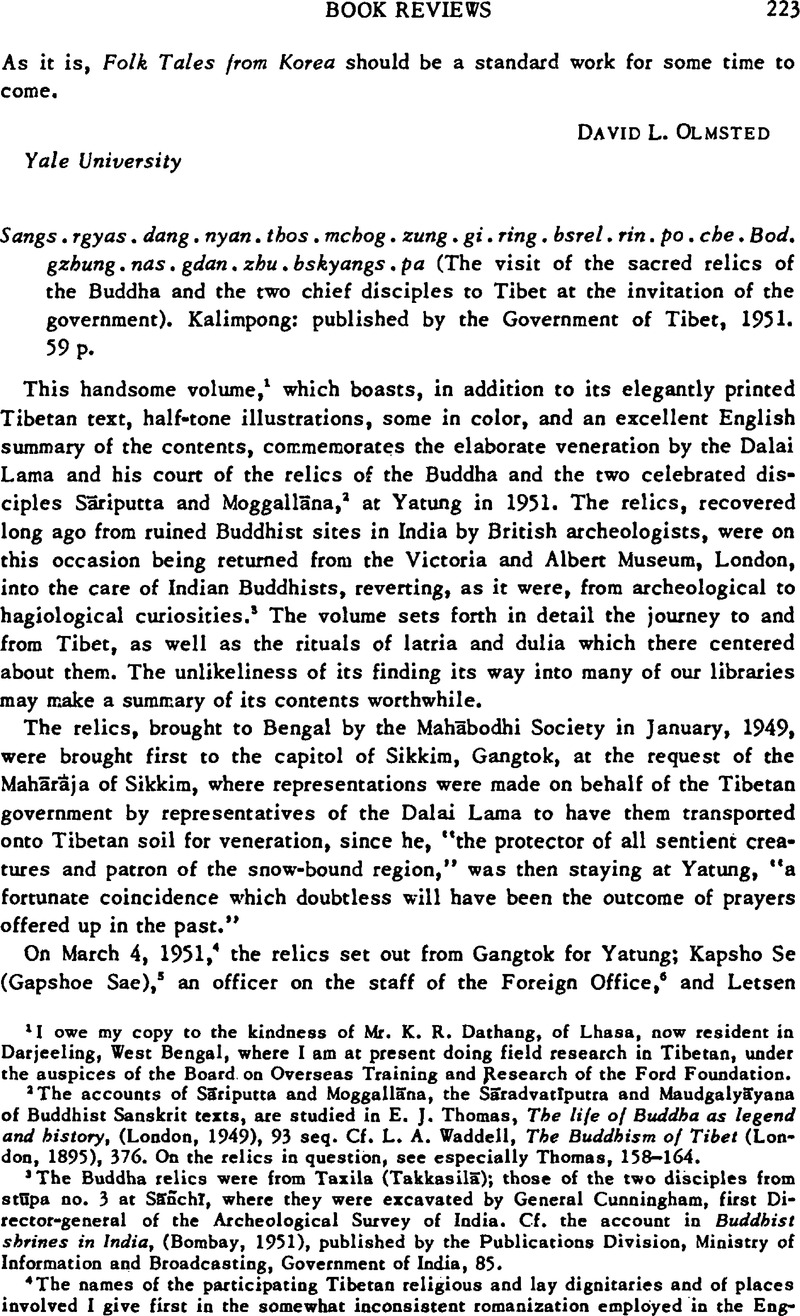No CrossRef data available.
Article contents
Sangs. rgyas. dang. nyan. thos. mchog. zung. gi. ring. bsrel. rin. po. che. Bod. gzhung. nas. gdan. zhu. bskyangs. pa (The visit of the sacred relics of the Buddha and the two chief disciples to Tibet at the invitation of the government). Kalimpong: published by the Government of Tibet, 1951. 59 p.
Published online by Cambridge University Press: 23 March 2011
Abstract

- Type
- Book Reviews
- Information
- Copyright
- Copyright © The Association for Asian Studies, Inc. 1954
References
1 I owe my copy to the kindness of Mr. K. R. Dathang, of Lhasa, now resident in Darjeeling, West Bengal, where I am at present doing field research in Tibetan, under the auspices of the Board on Overseas Training and Research of the Ford Foundation.
2 The accounts of Sāriputta and Moggallāna, the Sāradvatīputra and Maudgalyāyana of Buddhist Sanskrit texts, are studied in Thomas, E. J., The life of Buddha as legend and history, (London, 1949Google Scholar), 93 seq. Cf. Waddell, L. A., The Buddhism of Tibet (London, 1895Google Scholar), 376. On the relics in question, see especially Thomas, 158–164.
3 The Buddha relics were from Tazila (Takkasilā); those of the two disciples from stūpa no. 3 at Sānchī, where they were excavated by General Cunningham, first Director-general of the Archeological Survey of India. Cf. the account in Buddhist shrines in India, (Bombay, 1951Google ScholarPubMed), published by the Publications Division, Ministry of Information and Broadcasting, Government of India, 85.
4 The names of the participating Tibetan religious and lay dignitaries and of places involved I give first in the somewhat inconsistent romanization employed in the English summary of the volume, followed, in the case of the personal names only, in parentheses by the same in the Lhasa dialect transcribed, but omitting tone marks, according to the system of Chao, Y. R. and Yu, T. C., Love songs of the sixth Dalai Lama Tshangs-dbyangs-rgya-mtsho, Peiping: Academia Sinica, National research institute of history and philology, Monographs, Series A No. 5, 1930Google Scholar. The conventional orthography of the Tibetan script is given in literal transliteration in the notes, for all names, as also for the official titles.
5 ka. shod. sras.
6 phyi. rgyal. las. khungs. kyi. las. bya.
7 las. tshan. thub. bstan. nor. bu.
8 dkar.po.nang.
9 mtsho. mgo.
10 rna.thod.lah.
11 sku. srung. mdah. dpon.
12 pha.lha.sras.
13 chu. hbi. thang.
14 bkah. brgyud. tshe. chog. gling.
15 rtse. mgron. rgyal. mtshan. bstan. hphel.
16 snehi. shar. dza. sag. thub. bstan. thar. pa.
17 bod.gzhung.phyi.rgyal.do.dam.sku.bear.
18 sku. tshab. sku. bear. mkhan. tshab.
19 mkhan. drung. tah. bla. ma. [rong. mam. sras.]thub. bstan. nor. bzang.
20 dung. dkar. dgon. pa. kra. shis. lhun. grup.
21 mkhan. tshab. tah. bla.ma.
22 gzhung. zhabs. kyi. gtso. bo.
23 bkah. blong. bla. ma. ram. pa.
24 bkah. blong. zur. khang.
25 yongs. hdzin. [chen. po.]shar. pa. chos. rje. gling.
26 mtshan. zhabs. [dar. han.]khri. byang. rin. po. che.
27 stag. htsher. [mehog. spyul.]rin. po. che.
28 sku.tshab.
29 rtse. mgron. rgyal. mtshan. bstan. hphel.




